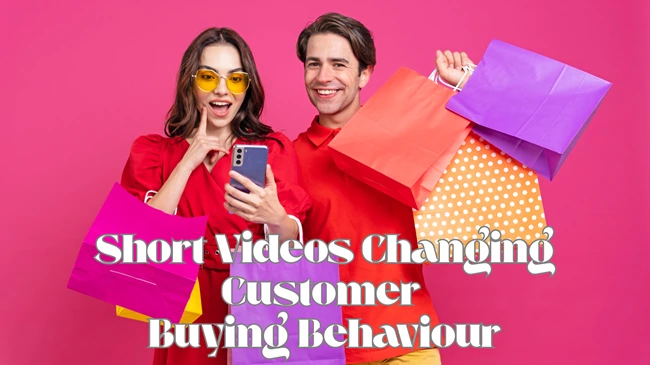The Rise of a New Digital Rhythm
There was a time when consumers would browse the Sunday newspaper for deals, flip through television channels for brand ads, or search Google for product reviews before making a purchase. That era has quietly faded.
Today, the modern consumer is living in a loop of streaming, scrolling, searching, and shopping—a behavior pattern driven almost entirely by the explosive rise of short video content on platforms like Instagram Reels, TikTok, YouTube Shorts, and even Facebook Stories.
How Short Video Trends Have Transformed Consumer Behaviour
Short videos are no longer just entertainment; they are influence machines. They are shaping perceptions, guiding purchases, and rewriting the rulebook of how brands connect with consumers.
Let’s explore how this new behavior pattern has evolved, disrupted traditional marketing, redefined performance strategies, and what you need to do as a brand to stay relevant.

The Shift – From Passive Consumption to Instant Decisions
Experience
Consumers today don’t just see content—they experience it.
Short-form videos are bite-sized bursts of storytelling, often wrapped in authenticity, emotion, or entertainment. The immersive experience of a 15-second product demo, a transformation video, or a quick unboxing can often create more impact than a 30-second TVC ever could.
These videos aren’t interrupting content—they are the content.
Here’s what’s changed:
- Attention spans are shorter, but the intent to act is sharper.
- People now scroll with purpose—whether it’s inspiration, humor, education, or deals.
- Video-first discovery is replacing text-based search. A consumer now learns about a new skincare brand via a Reel, not Google.
The Collapse of the Funnel
Expertise
Traditional marketing followed a familiar funnel: Awareness → Consideration → Decision → Retention.
But short-form content has compressed the entire funnel into a single scroll.
Let’s look at an example:
- A user watches a 10-second fashion haul video on Instagram.
- She sees the product, its price, a relatable testimonial, and the brand tag—all in one shot.
- Within moments, she taps “Shop Now,” checks a couple of reviews, and hits “Buy.”
What just happened? Discovery, trust-building, and purchase—all within 90 seconds.
This behavioral change means:
- The customer journey is no longer linear.
- Impulse buying is the new norm.
- Brands need to focus on micro-moments rather than prolonged nurture campaigns.
Branding Has Gone Native
Authoritativeness
Branding used to be about creating an identity and broadcasting it across media channels. It was polished, glossy, and perfectly scripted.
Now? Branding thrives in raw, native environments.
Thanks to short video platforms:
- A creator doing a “day in my life” vlog with your product builds more credibility than a high-production TV ad.
- A meme trend that your brand joins can do more for awareness than a full-blown campaign.
- A 30-second customer reaction video is worth more than a scripted brand endorsement.
Brands like CeraVe, Duolingo, and Blinkit have cracked this:
- CeraVe’s dermatologist videos blend expert opinion with native humor.
- Duolingo’s owl mascot on TikTok engages, educates, and entertains all at once.
- Blinkit’s snappy Reels make groceries feel like a dopamine hit.
In this new landscape:
- Authenticity is the new authority.
- Native integration beats intrusive promotion.
- User-Generated Content (UGC) is branding gold.
The Evolution of Performance Marketing
Trustworthiness
Performance marketing once thrived on cold data: impressions, clicks, CTRs, CPCs, and ROAS. It was a numbers game.
But now? It’s a trust game.
Here’s what’s changed:
- People don’t trust ads—they trust people.
- A user testimonial video shot on an iPhone outperforms a polished product carousel.
- Storytelling-based creatives on Meta platforms deliver stronger engagement than direct response banners.
Brands must now think like content creators, not advertisers.
Key Takeaways for Performance Marketers:
- Focus on creator-led ads, especially on platforms like Instagram and TikTok.
- Invest in short video ad creatives with hooks in the first 2 seconds.
- Test multiple versions of video formats tailored to trends and seasonal content.
- Use dynamic product ads blended with UGC for retargeting.
If you’re still running traditional static ads with price-point messaging, you’re already behind.
The “Infinite Scroll” Mindset
Today’s consumer is in an infinite scroll loop. This changes everything.
They want quick hits of value:
- Tips
- Hacks
- Real-life results
- Before/after stories
If your brand can deliver value in the scroll, you’ve won their attention—and maybe their wallet.
Here’s what works:
- How-to clips
- Fast unboxings
- Real reviews
- Humor-laced storytelling
It’s not about being viral. It’s about being valuable in under 30 seconds.
What Brands Must Focus On
To succeed in this new behavioral ecosystem, here’s a playbook you must embrace:
1. Prioritize Vertical Video Content
Every campaign should have short-form assets. Think 9:16. Think mobile-first. Think native.
2. Collaborate with Niche Creators
Don’t chase influencers with millions of followers. Find those who command trust in your category, even with 10K followers. Their content converts better.
3. Add a Content Layer to Performance
Great performance marketing today isn’t just about the media buy. It’s about what the user sees in that first second. Build ads with storytelling, voiceovers, testimonials, and humor.
4. Use UGC as the New Creative Currency
Turn your customers into your best marketers. Repurpose UGC in your ads, on product pages, and across socials.
5. Focus on Discovery, Not Just Demand
Create content that educates, entertains, and inspires—not just sells. Discovery-driven content leads to long-term brand love.
Final Thoughts – Adapting to the Age of Acceleration
This is the age of accelerated attention and instant influence.
Streaming, scrolling, searching, and shopping are no longer siloed actions. They are part of a new, fluid, and fast-paced consumer rhythm.
Brands that still rely only on traditional marketing or static performance creatives will slowly fade into irrelevance.
To thrive:
- Embrace speed.
- Embrace storytelling.
- Embrace short-form.
- Most importantly, embrace the consumer as the new creator.
Your brand doesn’t need to go viral. It needs to be seen, trusted, and remembered in a scroll.
How Short Video Trends Have Transformed Consumer Behaviour : FAQs
1. Why are short videos important for marketing?
Short videos grab attention quickly, deliver brand messages in seconds, and are proven to increase engagement and conversions—especially on mobile platforms.
2. How can traditional brands adapt to this change?
By creating short form, native style content, collaborating with niche creators, and using UGC in both branding and performance campaigns.
3. Is performance marketing still relevant?
Absolutely. But it’s now content-driven. Creatives play a more significant role than ever in ROAS, especially with shorter funnels.
4. Should brands focus only on TikTok and Instagram Reels?
No. YouTube Shorts, Facebook Reels, and even Pinterest Video Pins are equally important depending on your audience. The goal is platform diversity.

Hi, I’m Prashant Jain — a curious soul, storyteller, and content creator at heart.I’ve always been drawn to the world of entertainment, travel, sports, health & lifestyle — not just as a writer, but as someone who genuinely lives these experiences. Whether I’m binge-watching the latest OTT series, exploring offbeat spiritual destinations in India, or diving deep into wellness routines and cricket match insights, I love sharing what I discover with like-minded readers.
PopNewsBlend is my way of blending personal journeys with meaningful stories — ones that inform, inspire, and keep you ahead of the curve. Everything I write comes from real observations, hands-on experiences, and a deep passion for understanding the world around us.







